
Article and photos by Joe Mock, BaseballParks.com
A version of this article appeared in USA TODAY Sports Weekly. Used here by permission. All rights reserved
OAKLAND, California During the sunny afternoon game on September 8, 2024 at the Oakland Alameda County Coliseum, Michael Phillips (see photo) sits alone. In fact, he is the only one sitting in section 323 – or for that matter, for two sections in either direction.
 “I’m here alone with my thoughts,” he explains. “I have so many memories here.”
“I’m here alone with my thoughts,” he explains. “I have so many memories here.”
This is the 33rd A’s game he’s attended this season. He’s been coming to games here for 43 years, as he grew up and still lives about two miles from the stadium. His first job out of high school was as an usher here.
“The stadium now isn’t kept up well,” he laments. “The food sucks. But it’s ours.”
Knowing that this is the final season for the A’s in Oakland is taking a heavy emotional toll on A’s fans like Phillips. “Here you have a storied franchise with so much history, so many great moments and so many great players. To get to this point is just sad.
“It’s devastating. Heartbreaking.”
The Oakland A’s last homestand at the Coliseum started September 19 against the Yankees, with the finale occurring on Thursday the 26th at 12:37 PDT against the Rangers. A daytime contest during the week is referred to as a getaway game.
In the A’s case, it’s literally true.
Philly to KC to Oakland to …
Known primarily as the Athletics in their early years, the team called Philadelphia home from the formation of the American League in 1901 through 1954. The final 46 seasons were spent at Shibe Park, famous for its neighborhood location where fans could watch games from the roofs of row houses across the street.
Following 13 years in Kansas City at Municipal Stadium, the Athletics completed their westward migration when team owner Charlie Finley moved them to the two-year-old Coliseum in Oakland. Except for a homestand in 1996 when construction forced the team to play in Las Vegas, the Coliseum has been the A’s only regular-season home since 1968.
Of the 30 parks currently in use in Major League Baseball, only Fenway Park, Wrigley Field and Dodger Stadium were constructed before Oakland’s stadium. As a product of the 1960s, the Coliseum is round and designed for both football and baseball. Somewhat derisively, stadiums like this are called “doughnuts” or “cookie cutters.”
When the Coliseum reached its 40th birthday in 2006, the ballpark landscape had shifted drastically from the cookie-cutter days. Gone were the multi-use stadiums in cities like St. Louis, Philadelphia, San Francisco and Pittsburgh, and in their place were baseball-only showplaces like Busch Stadium, Citizens Bank Park, Oracle Park and PNC Park.
Even at that point, the Coliseum was clearly substandard – both for fans and players. To address this, the A’s owner at the time, Lew Wolff, asked the city to green-light a new baseball-only park near the Coliseum’s current location. When that proposal failed, Wolff employed parallel approaches: continue to negotiate with the city of Oakland; find another city in the Bay Area to host a new facility.
Regarding the latter, in 2005 the team created site plans for locations near Interstate 880 south of Oakland, including an elaborate mixed-use development to be called Cisco Field in Fremont. There were always obstacles raised by local residents and environmentalists, so in 2009 the ownership of the A’s turned their attention southward, to Santa Clara and San Jose, at the southern end of the San Francisco Bay.
The battle over San Jose
The most likely destination for the A’s – from the perspectives of public transportation, population base and especially potential corporate sponsors – was fast-growing San Jose. By a decade ago, it ranked 10th in the U.S. in population.
While there was little doubt the A’s would prosper in San Jose, the Giants argued that they owned that lucrative market as part of their territory. They felt the area was theirs because the A’s essentially gave it to them to convince the Giants not to move the franchise to Florida in 1990. This included giving the Giants permission to build a replacement for Candlestick Park in San Jose if they wanted to.
So the Giants stayed in California. However, not only did they not move south to build a new ballpark in San Jose, they went in the opposite direction. Their new stadium was constructed five miles farther away from San Jose, as Oracle Park is near downtown San Francisco.
Well, when the shoe was on the other foot and it was the A’s who needed to leave an out-of-date stadium, the Giants didn’t want to give up what they felt was their territory in San Jose in order keep the A’s in the Bay area. Even commissioner Bud Selig said at the time, “In 1990 when (Giants owner) Bud Lurie wanted to move the Giants to San Jose, Walter Haas, the wonderful owner of the Oakland club, who did things in the best interest of baseball, granted permission. What got lost there is, they didn’t feel it was permission in perpetuity.”
This is when lawyers got involved and Selig commissioned a “blue ribbon committee” to study whether the A’s should be permitted to build a park in San Jose. Their work dragged on for years, all while the Coliseum was falling into greater disrepair.
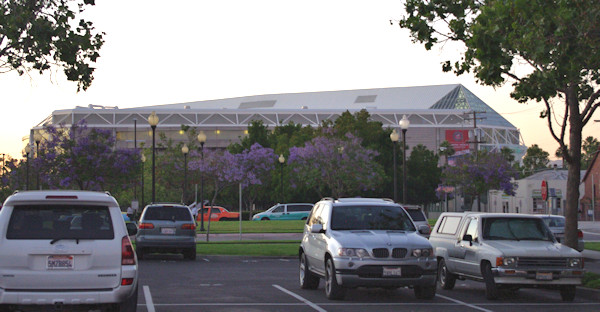
The A’s and the city of San Jose even had a site picked out for the new park (see photo), adjacent to train stations and the Sharks hockey arena. The team and the city pushed the matter all the way to the U.S. Supreme Court, which ultimately refused to hear the case in 2015, effectively killing any hope of the team moving to Silicon Valley.
This meant the Giants’ stance eventually resulted in their having the entire Bay area to themselves now that the A’s are leaving. Funny how things work out, isn’t it?
While still negotiating with other cities in the area, the A’s also undertook extensive studies on two locations near downtown Oakland, first in the Peralta neighborhood, then at Howard Terminal on the edge of the Bay. In 2018, the A’s released architectural drawings showing what an environmentally friendly ballpark on that waterfront site would look like.
This was seen as the last-ditch effort for the team to remain in Oakland. In 2021, when little progress had been made between the A’s and the city (and it appears that both the city and the team hold some responsibility for this), MLB permitted the A’s to start negotiating with markets outside of the Bay Area. The city of Oakland’s lack of funds, environmental concerns about the Howard Terminal site and the filing of numerous lawsuits to block the project prompted the A’s to reach a huge decision. On November 16, 2023, the team announced their intention to follow the Raiders, Oakland’s former NFL team, to Las Vegas.
“We tried very hard to make a deal in Oakland,” baseball commissioner Rob Manfred told reporters when the announcement was made. “If you look at the situation objectively, we had no choice but to move on.”
In an open letter to A’s fans immediately before the team’s final series in 2024, franchise owner John Fisher said “Staying in Oakland was our goal, it was our mission, and we failed to achieve it. And for that I am genuinely sorry.”
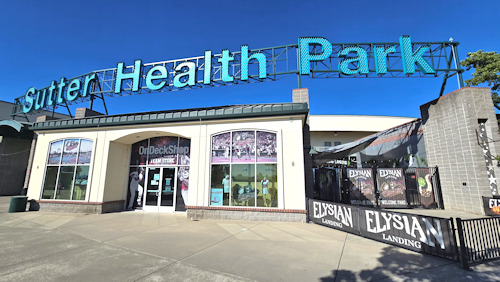
The most optimistic scenario is that the design and construction of a new ballpark near The Strip in Las Vegas will be completed by 2028. The proposed site for the $1.5-billion project is where the fabled Tropicana casino hotel was just demolished. In the meantime, the A’s elected not to stay in Oakland as their lease on the Coliseum ends this year. Instead they’ll play the next three seasons in Sutter Health Park (see photo), a Triple-A stadium in West Sacramento, 86 miles from the Coliseum.
Should the deal in Las Vegas fail to materialize, there is speculation that the A’s might just stay in Sacramento in a brand-new stadium. (Irony: the Minor League team in Sacramento, the River Cats, just happens to be the Giants’ AAA affiliate.)
Coming and going
The NFL team now known as the Las Vegas Raiders actually settled into the Oakland Coliseum before the A’s, as they were the first tenant when it opened in 1966.
Led by hard-driving Al Davis, who by 1972 went from part owner to managing general partner of the franchise, the Raiders played in the second Super Bowl following the 1967 season, losing to Green Bay in Miami. They won Super Bowls following the 1976 season (under the guidance of coach John Madden – yes, he was a coach before a video game was named after him) and 1980 season (under coach Tom Flores).
Davis wanted luxury suites added to the Coliseum, but the city of Oakland was reluctant to do so. Consequently, after winning a lawsuit after the other NFL owners refused to let him leave Oakland, Davis moved the franchise to a larger stadium and much bigger market in Los Angeles in 1982.
After Oakland agreed to a significant increase in the capacity at the Coliseum, Davis moved his team back to Oakland in 1995. The additional seats were all beyond the baseball field’s outfield. The massive new $200 million structure – dubbed Mount Davis — dwarfed the rest of the seating bowl, and sadly blocked what had been a lovely view of Oakland’s foothills (evidence of this can be seen in the photo at the top of this page).
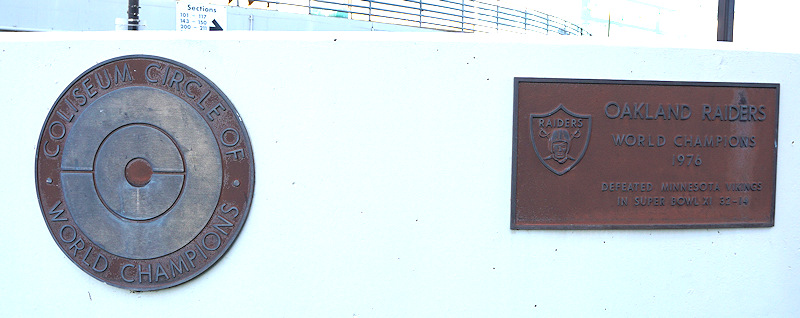
After Davis passed away in 2011, his son Mark assumed control. Again dissatisfied with the Coliseum, the younger Davis made overtures about moving back to Southern California, but settled instead to move to a new stadium in Las Vegas. The Raiders played their last game at the Coliseum on December 15, 2019.
As observed by authors Andy Dolich and Dave Newhouse in the book “Goodbye, Oakland,” it’s “the only city in America to be abandoned by the same team twice.”
Now that the A’s are moving away as well, no longer is there a stadium in MLB that hosted both the NFL and baseball.
Phillips notes that he typically attended a couple of Raiders games at the Coliseum each year before their move to Las Vegas, “but the way they came and left and came back and left again, it’s hard to feel the same about the Raiders as I do about the A’s.
“The A’s have been here my whole life,” notes the 45 year old.
Bash Brothers and Moneyball
When the A’s arrived in Oakland in 1968, owner Finley was anxious to attract fans with a winning team. He “started building (talent) there at the end of the time in Kansas City,” notes Mike Selleck, the A’s baseball information manager. “When they came to play in Oakland, they made three straight World Series. So Finley was able to recognize talent.”
Finley also had a penchant for outside-of-the-box thinking, and his ingenuity and tendency to take risks prompted some noteworthy innovations — some that caught on and some that didn’t. Two that didn’t were an orange baseball and replacing last names with the players’ nicknames on the backs of their uniforms.
One idea that did catch on was colorful uniforms. Into the 1960s, baseball players typically wore white when home and gray on the road. In the book “Finley Ball,” author Nancy Finley deduced that Charlie had a sensory condition known as synesthesia, in which the person associates colors with certain numbers and letters. “Charlie was always fascinated with color, especially bright colors,” writes Nancy, who is the daughter of Charlie Finley’s business partner and cousin Carl Finley.
So Charlie had his A’s players wear bright yellows and greens, and a trend was born.
“Predictably, baseball’s old guard didn’t care for the uniforms,” writes Nancy. “At the 1963 All Star Game, the American League squad manager Ralph Houk — also the Yankees manager — refused to play the Athletics’ lone All Star because he felt the new green-and-gold uniforms were so undignified and beneath the game.”
The team with the colorful uniforms won the World Series in 1972, 1973 and 1974. The roster featured stars like Catfish Hunter, Vida Blue, Rollie Fingers and Joe Rudi.
Selleck feels that the unsung hero on those teams was third baseman Sal Bando. “He was the captain of the team, and I think he compares to some of the guys who made the Hall of Fame,” notes Selleck.
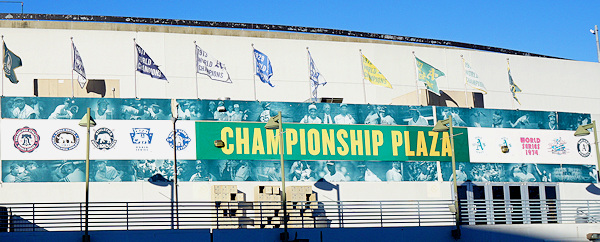
By the 1980s, slugging stars such as Mark McGwire and Jose Canseco – nicknamed the Bash Brothers — joined forces with arguably the best leadoff batter in the game’s history, Rickey Henderson. “That team in the ‘80s was just loaded with style and charisma,” adds Selleck. And they went to three straight World Series starting in 1988.
The A’s of that era coined the phrase “the Rickey run,” because Henderson would often walk, steal second and third base, then score on a sacrifice fly. “He’s the guy. He had style. Of all of those great guys, he might be the most electric player.”
The front office of the A’s was at the forefront of the analytics craze that has developed over the past four decades. “The A’s of the ‘80s were actually getting started with that,” explains Selleck. “They were looking at things like batter-pitcher matchups, lefty-righty stuff. And that was before computers.
“Once computers came around and you could analyze data more, then you had Billy Beane (at the time, A’s general manager) taking advantage of that as a way to improve the team.” Perhaps because the A’s often had one of the lowest payrolls in the Majors, this approach of doing more with less came to be called Moneyball, with Michael Lewis penning a best-selling book with that title. It chronicled Beane’s masterful use of analytics during the 2002 season – which included an American League record 20-game winning streak.
A movie based on the book was released in 2011. Brad Pitt earned an Oscar nomination for portraying Beane.
Even though the two teams are in different leagues, inter-league play allowed the A’s to face their cross-bay rivals the San Francisco Giants. “You always have your rivals in your own division, but it seems to me that the Giants, at least from the fans’ standpoint, is our biggest rivalry,” notes Selleck. In fact, the largest baseball crowd in Coliseum history was on July 21, 2018, when the A’s edged the Giants 4-3 in front of 56,310 fans.
On the field and at the gate, the lame-duck season of 2024 hasn’t been a successful one for the A’s. The team with the lowest payroll in the Majors is 20 games under .500, and is the only franchise to average fewer than 10,000 fans per game.
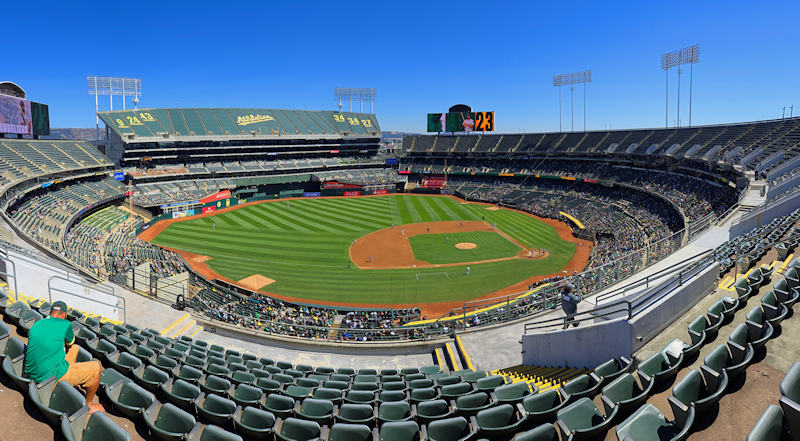
Place in history
Having been the host of MLB for 57 seasons certainly means the Coliseum is important in the sport’s history, even if it is anything but an architectural triumph.
In the broadcast booth for the Rangers during the A’s final series in Oakland is Hall of Famer Eric Nadel. Prior to the series’ start, he told us, “I love the Coliseum. So many great memories for me here, more than any other opponent’s ballpark by far.”
On his list of favorite games he’s called here are Nolan Ryan’s sixth career no-hitter in 1990 and the Rangers’ clinching the American League West in 2010 — the year they went on to the first World Series in franchise history.
Despite its history, the Coliseum has consistently ranked at the bottom of MLB’s 30 ballparks. When USA TODAY first asked me to rank the parks in a season-long series of articles in 2013, I placed it at #30. Prior to the 2024 season, USA TODAY’s eight baseball writers and editors each ranked all the parks from #1 to #30, and the consensus was that the Coliseum was dead last.
So it’s not really up for debate about whether this is a venue that is adequate to continue hosting Major League Baseball.
Childhood is leaving
It would not be accurate to say that there is a wide range of emotions among A’s fans regarding the team’s move out of Oakland. There are only two emotions: anger and sadness. And the latter is quite near the surface as the team prepares to depart.
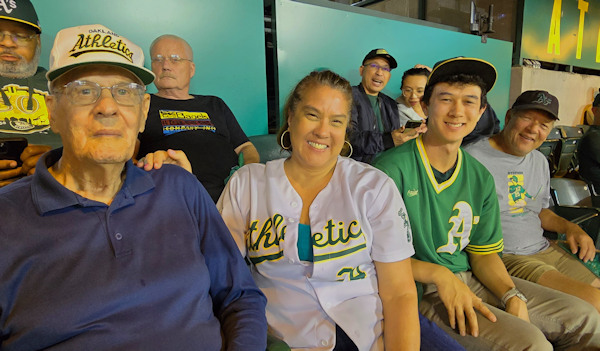 Jordan Leffler, 26, was born and raised in San Jose. What should have been a joyous occasion — having three generations of his family in attendance at the A’s game on September 6 — was instead a somber affair. (In the photo, Jordan’s 90-year-old grandfather Bill Hightchew is closest to the camera, then his mother Sandy, then Jordan, then his father Darrell.)
Jordan Leffler, 26, was born and raised in San Jose. What should have been a joyous occasion — having three generations of his family in attendance at the A’s game on September 6 — was instead a somber affair. (In the photo, Jordan’s 90-year-old grandfather Bill Hightchew is closest to the camera, then his mother Sandy, then Jordan, then his father Darrell.)
He explains that his great grandfather started the tradition of rooting for the A’s, taking Jordan’s father to a World Series game when Catfish Hunter and Rollie Fingers were stars of the team. “My earliest memories are watching an A’s-Angels game and the Bay Bridge World Series against the Giants.” That was in 1989 when manager Tony La Russa’s A’s swept San Francisco in a series most remembered for the earthquake moments before Game 3.
The A’s departure from Oakland is no less seismic. “It’s tragic what’s happening,” he notes. “There is so much history here. And it’s not just the A’s, but what the Raiders did was also awful.
“A big part of my childhood is leaving.”
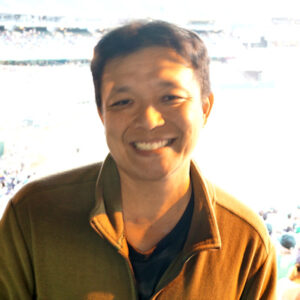 Ken Ozeki (see photo), 41, relies on the San Mateo-Hayward Bridge to get to the 30 A’s games that he has attended each year. He grew up and still lives in Foster City, on the other side of the Bay from Oakland.
Ken Ozeki (see photo), 41, relies on the San Mateo-Hayward Bridge to get to the 30 A’s games that he has attended each year. He grew up and still lives in Foster City, on the other side of the Bay from Oakland.
“It feels like a big part of my usual entertainment is going to disappear,” he says.
“I’ve seen amazing things here over the years, like Ichiro (Suzuki) throwing out a runner at third base during his rookie year. The Moneyball years were really great, and even though they kept trading away stars before they became free agents, they remained competitive.”
He feels the A’s should have “fought harder” to convince the Giants to let them move to the southern end of the Bay. “The Giants really pigeonholed the A’s that they had to stay only in Oakland.”
And if they had to leave Oakland, he thinks they shouldn’t have looked so far away, in places like Las Vegas. High-growth areas east of Oakland should have been possibilities. “If nothing else, they could’ve built a park in Livermore or Dublin, someplace where it would be easy to get to on BART (Bay Area Rapid Transit).”
He adds that he typically attends a few minor league games in Sacramento each season, but because the A’s have indicated that fans will have to purchase full or partial season tickets in order to see their games there starting in 2025, he can’t envision “investing the time and the cost.” Besides, he explains, “day games are brutal in the summer in Sacramento.”
Zero interest
The future of the Coliseum is no mystery. The land on which it rests has been sold to the African American Sports and Entertainment Group, which will construct a mixed-use development at the site. Demolition of the stadium is scheduled to begin after a minor league soccer team uses it next year.
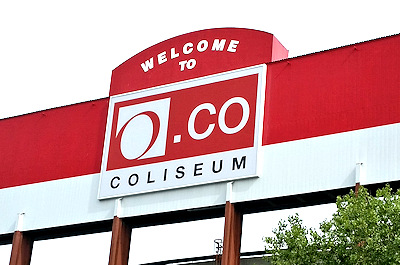 In addition to holding the dubious distinction of being the only stadium abandoned twice by the same team (the Raiders), the facility probably holds the record for most different names. The original name of Oakland Alameda County Coliseum was in place from its opening until 1997, when it took on its first corporate sponsor: UMAX. This quickly gave way to Network Associates. Then came McAfee, Overstock, which became O.co (see photo), and finally RingCentral. When the lack of a sponsor resulted in returning to the facility’s original name last year, there had been no fewer than six corporate names attached to the stadium. Surely that’s a record.
In addition to holding the dubious distinction of being the only stadium abandoned twice by the same team (the Raiders), the facility probably holds the record for most different names. The original name of Oakland Alameda County Coliseum was in place from its opening until 1997, when it took on its first corporate sponsor: UMAX. This quickly gave way to Network Associates. Then came McAfee, Overstock, which became O.co (see photo), and finally RingCentral. When the lack of a sponsor resulted in returning to the facility’s original name last year, there had been no fewer than six corporate names attached to the stadium. Surely that’s a record.
Regardless of the numerous name changes, locals have always referred to it as The Coliseum.
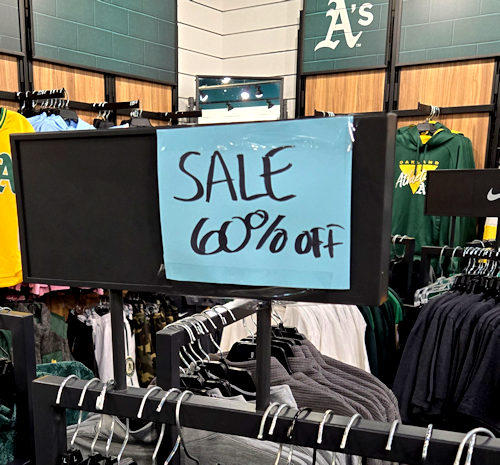 While in his lonely perch in the Coliseum’s upper deck, lifelong A’s fan Phillips makes it clear how much interest he has in making the trek to Sacramento to watch the team next year: “Zero.”
While in his lonely perch in the Coliseum’s upper deck, lifelong A’s fan Phillips makes it clear how much interest he has in making the trek to Sacramento to watch the team next year: “Zero.”
“Think about this,” he explains. “They’d be asking me to travel two hours each way to see a team with the lowest payroll in baseball. That’s the product they’re asking me to support.”
Spencer Olinek moved to Oakland from Detroit in 2016. He has enjoyed taking the BART trains to the ballpark, but when the A’s announced that they were moving, “I refused to buy any more advance tickets because I didn’t want any of my money to go into the pocket of Fisher.”
Now that Olinek is attending his last game at the Coliseum, “It’s all so palpable now. The team has one foot out the door, with lots of concession stands closed and people not caring. But it’s sadder than I anticipated. There’s more of a melancholy feeling than I thought I’d have.
“I know I won’t be here again.”
Mock covers sports facilities for USA TODAY Sports